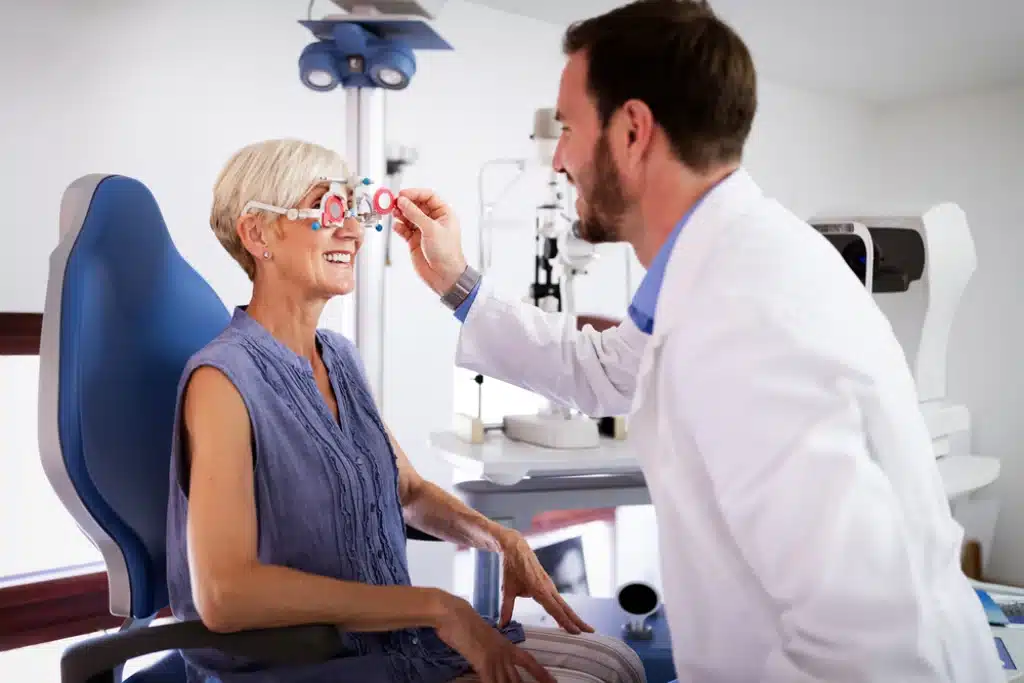Medically Reviewed by: Edward C. Wade, M.D., F.A.C.S.
Does the Corneal Flap Heal After LASIK?
Over the years, we’ve noticed that one question, in particular, seems to come up often during our LASIK consultations: Does the corneal flap heal after LASIK?
While the informed answer to that question has some nuances (which we’ll cover here), the essential answer is: Yes. In fact, the LASIK flap dislocation percentage is less than one half of 1%.
If you’re a LASIK candidate and follow through with the standard post-operative care for LASIK eye surgery, chances are that the only thing you’ll have to worry about is after LASIK is what type of fancy non-prescription sunglasses you’re going to buy.
Now let’s get to why that’s true.
Why is there confusion about the corneal flap healing after LASIK?
Many people are afraid of putting contacts in their eyes, let alone electing to have LASIK eye surgery. Every few years, someone plays off of those fears and raises suspicion about the integrity of the LASIK procedure.
One of the more recent scares concerned whether or not the corneal flap actually heals. As this rumor was perpetuated, the subtleties of the corneal flaps healing process (which we’ll get into in a moment) were only partially or incorrectly explained.
The surgeons at Eye Center of Texas have performed over 75,000 successful LASIK surgeries. They can and do attest to the fact that the surgery is perhaps the safest and most researched elective surgeries available.
But you don’t have to take our word for it. After conducting many studies (including this one) the U.S. military decided that LASIK was so beneficial to a soldiers’ performance that they’ve had the procedure performed on hundreds of thousands of U.S. military personnel.
How do your eyes heal after LASIK?
Alright, so how does the corneal flap heal after LASIK? The corneal flap heals in different ways at different parts of the flap. We’ve broken it down for you here:
- Epithelial layer: Your epithelium is the very, very thin layer found on the surface of the cornea. It begins healing almost immediately after the flap has been replaced and is the reason that you don’t feel a “line” between the flap and the rest of your eye.
- Stroma: Your stroma is what makes up most of your cornea’s mass. Stromal healing takes place along thickest parts of the flap’s edges.
- Bottom layer: Here is where the recent round of, “Does the corneal flap heal after LASIK” originates. During the corneal flap’s healing process, the bottom layer of the flap does not “join” with the surface underneath it… which is actually a very good thing. If it did, you’d be stuck with an opaque layer of collagen that would do the exact opposite of what LASIK is supposed to do: improve your sight.
If you’re thinking, “That’s all well and good, but how long does it take the flap to heal after LASIK?” rest assured. Your corneal flap begins healing immediately after the surgery. It will be mostly healed after 24 hours after your procedure. For more information about healing times, check out our post on the LASIK recovery timeline.
How do I know if my corneal flap moved?
Let’s get down to the direct questions. Can the flap be moved after LASIK? And if so, how can you tell if it’s moved? Like any surgery, LASIK surgery does come with risks. After the first day of healing your flap can move, but only under extreme circumstances. Check out a timeline to learn more about LASIK recovery.
What do we mean by extreme circumstances? Let’s say a LASIK patient is involved in a high-impact accident on or around their eyes. In this case, there is a small but real chance that the flap can move.
Now let’s say you accidentally rubbed your eyes a few days after LASIK, and you’re concerned that you’ve moved the flap. In this case, it’s extraordinarily unlikely that your flap will move.
Here’s a general rule to live by with regard to corneal flap dislocation: If you’re not sure whether or not your corneal flap has moved, then your corneal flap has not moved. In the very unlikely event of corneal flap dislocation, patients will feel immediate pain and should seek emergency treatment.
Why would I need reading glasses after LASIK?
LASIK surgery addresses refractive errors in your vision: nearsightedness, farsightedness, and astigmatism. Standard LASIK procedure does not address presbyopia, which is the hardening of the eye that’s a natural part of your eye’s aging process. That’s why some LASIK patients will eventually need to wear glasses to read as they get older.
Patients concerned about presbyopia (also known as near vision) can find more helpful information in our posts on LASIK eye surgery for presbyopia and resource page for additional presbyopia solutions.
See clearly again at Eye Center of Texas
Have other questions like, “Does the corneal flap heal after LASIK?” We’re here to help. Eye Center of Texas is known for providing some of the best LASIK in Houston. As we mentioned earlier, our surgeons have successfully restored the vision of over 75,000 patients (and counting!) with LASIK.
Come see why over 300 eye doctors refer their patients to Eye Center of Texas. Call us at 713-395-1515 or request an appointment online today for a LASIK consultation.
Financing Options Available
Apply today to find a financing option that meets your needs.
Our Locations
Houston/Bellaire
6565 W. Loop S., Suite 650Bellaire, TX 77401
Medical Office:
713-797-1010
Medical Fax:
713-357-7276
LASIK/Near Vision:
Office: 713-395-1515
Fax: 713-357-7278
Pasadena
4415 Crenshaw RoadPasadena, TX 77504
Medical Office:
281-977-8800
Medical Fax:
281-977-8877
Sugar Land
15200 S.W. Freeway, Suite 130Sugar Land, TX 77478
Medical Office:
281-277-1010
Medical Fax:
281-277-4504
Clear Lake
455 E. Medical Center Blvd., Suite 110Webster, TX 77598
Medical Office:
281-332-1397
Medical Fax:
281-282-9152
Katy
Greenhouse Medical Plaza2051 Greenhouse Road, Suite 110
Houston, TX 77084
Medical Office:
346-547-7070
Medical Fax:
281-214-2971
The Woodlands/Conroe
100 Medical Center Blvd., Suite 118Conroe, TX 77304
Medical Office:
936-647-1610
Medical Fax:
936-647-1620


